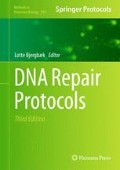Abstract
The chicken B cell line DT40 has been widely used as a model system for reverse genetics studies in higher eukaryotes, because of its advantages including efficient gene targeting and ease of chromosome manipulation. Although the genetic approach using the RNA interference technique has become the standard method particularly in human cells, DT40 still remains a powerful tool to investigate the regulation and function of genes and proteins in a vertebrate system, because of feasibility of easy, rapid, and clear genetic experiments. The use of DT40 cells for DNA repair research has several advantages. In addition to canonical assays for DNA repair, such as measurement of the sensitivities toward DNA damage reagents, it is possible to measure homologous recombination and translesion synthesis activities using activation-induced deaminase (AID)-induced diversification of the immunoglobulin locus. In this chapter, we would describe a detailed protocol for gene disruption experiments in DT40 cells.
Access this chapter
Tax calculation will be finalised at checkout
Purchases are for personal use only
References
Baba TW, Giroir BP, Humphries EH (1985) Cell lines derived from avian lymphomas exhibit two distinct phenotypes. Virology 144:139–151
Buerstedde JM, Takeda S (1991) Increased ratio of targeted to random integration after transfection of chicken B cell lines. Cell 67:179–188
Sale JE, Calandrini DM, Takata M, Takeda S, Neuberger MS (2001) Ablation of XRCC2/3 transforms immunoglobulin V gene conversion into somatic hypermutation. Nature 412:921–926
Okada T, Sonoda E, Yamashita YM, Koyoshi S, Tateishi S, Yamaizumi M, Takata M, Ogawa O, Takeda S (2002) Involvement of vertebrate polκ in Rad18-independent postreplication repair of UV damage. J Biol Chem 277:48690–48695
Fukushima T, Takata M, Morrison C, Araki R, Fujimori A, Abe M, Tatsumi K, Jasin M, Dhar PK, Sonoda E, Chiba T, Takeda S (2001) Genetic analysis of the DNA-dependent protein kinase reveals an inhibitory role of Ku in late S-G2 phase DNA double-strand break repair. J Biol Chem 276:44413–44418
Johnson RD, Liu N, Jasin M (1999) Mammalian XRCC2 promotes the repair of DNA double-strand breaks by homologous recombination. Nature 401:397–399
Consortium, I. C. G. S (2004) Sequence and comparative analysis of the chicken genome provide unique perspectives on vertebrate evolution. Nature 432:695–716
Arakawa H, Saribasak H, Buerstedde JM (2004) Activation-induced cytidine deaminase initiates immunoglobulin gene conversion and hypermutation by a common intermediate. PLoS Biol 2:E179
Inabe K, Ishiai M, Scharenberg AM, Freshney N, Downward J, Kurosaki T (2002) Vav3 modulates B cell receptor responses by regulating phosphoinositide 3-kinase activation. J Exp Med 195:189–200
Nanda I, Shan Z, Schartl M, Burt DW, Koehler M, Nothwang H, Grutzner F, Paton IR, Windsor D, Dunn I, Engel W, Staeheli P, Mizuno S, Haaf T, Schmid M (1999) 300 million years of conserved synteny between chicken Z and human chromosome 9. Nat Genet 21:258–259
Yamamoto K, Ishiai M, Matsushita N, Arakawa H, Lamerdin JE, Buerstedde JM, Tanimoto M, Harada M, Thompson LH, Takata M (2003) Fanconi anemia FANCG protein in mitigating radiation- and enzyme-induced DNA double-strand breaks by homologous recombination in vertebrate cells. Mol Cell Biol 23:5421–5430
Hirano S, Yamamoto K, Ishiai M, Yamazoe M, Seki M, Matsushita N, Ohzeki M, Yamashita YM, Arakawa H, Buerstedde JM, Enomoto T, Takeda S, Thompson LH, Takata M (2005) Functional relationships of FANCC to homologous recombination, translesion synthesis, and BLM. EMBO J 24:418–427
Lemaire R, Prasad J, Kashima T, Gustafson J, Manley JL, Lafyatis R (2002) Stability of a PKCI-1-related mRNA is controlled by the splicing factor ASF/SF2: a novel function for SR proteins. Genes Dev 16:594–607
Sauer B, Henderson N (1988) Site-specific DNA recombination in mammalian cells by the Cre recombinase of bacteriophage P1. Proc Natl Acad Sci U S A 85:5166–5170
Zhang Y, Wienands J, Zurn C, Reth M (1998) Induction of the antigen receptor expression on B lymphocytes results in rapid competence for signaling of SLP-65 and Syk. EMBO J 17:7304–7310
Fukagawa T, Regnier V, Ikemura T (2001) Creation and characterization of temperature-sensitive CENP-C mutants in vertebrate cells. Nucleic Acids Res 29:3796–3803
Su X, Bernal JA, Venkitaraman AR (2008) Cell-cycle coordination between DNA replication and recombination revealed by a vertebrate N-end rule degron-Rad51. Nat Struct Mol Biol 15:1049–1058
Nishimura K, Fukagawa T, Takisawa H, Kakimoto T, Kanemaki M (2009) An auxin-based degron system for the rapid depletion of proteins in nonplant cells. Nat Methods 6:917–922
Ausubel FM, Brent R, Kingston RE, Moore DD, Seidman JG, Smith JA, Struhl K (1999) Current protocols in molecular biology. John Wiley and Sons, Inc., Hoboken, New Jersey
Wang X, Takenaka K, Takeda S (2010) PTIP promotes DNA double-strand break repair through homologous recombination. Genes Cells 15:243–254
Yasuda T, Maeda A, Kurosaki M, Tezuka T, Hironaka K, Yamamoto T, Kurosaki T (2000) Cbl suppresses B cell receptor-mediated phospholipase C (PLC)-γ2 activation by regulating B cell linker protein-PLC-γ2 binding. J Exp Med 191:641–650
Acknowledgements
The protocols resented here is the combinations of those developed through the work of our previous and current colleagues. The authors’ work was supported in part by Grants-in aid from the Ministry of Education, Science, Sports, and Culture of Japan (MI and MT). Financial support were also provided by the Uehara Memorial Foundation (MT), Takeda Foundation (MT), the Ichiro Kanehara Foundation (MI), and the Mochida Memorial Foundation for Medical and Pharmaceutical Research (MI).
Author information
Authors and Affiliations
Corresponding author
Editor information
Editors and Affiliations
Rights and permissions
Copyright information
© 2012 Springer Science+Business Media New York
About this protocol
Cite this protocol
Ishiai, M., Uchida, E., Takata, M. (2012). Establishment of the DNA Repair-Defective Mutants in DT40 Cells. In: Bjergbæk, L. (eds) DNA Repair Protocols. Methods in Molecular Biology, vol 920. Humana Press, Totowa, NJ. https://doi.org/10.1007/978-1-61779-998-3_4
Download citation
DOI: https://doi.org/10.1007/978-1-61779-998-3_4
Published:
Publisher Name: Humana Press, Totowa, NJ
Print ISBN: 978-1-61779-997-6
Online ISBN: 978-1-61779-998-3
eBook Packages: Springer Protocols

